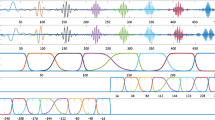Abstract
This paper presents a comparison of basic progressive and wavelet radiosity algorithms. Several variants of each algorithm were run on a set of scenes at several parameter settings, and results were examined in terms of their error, speed, and memory consumption. We did not compare more advanced variations such as clustering or discontinuity meshing. Our results show that progressive radiosity with substructuring works fairly well for all scenes. Among wavelet methods, the Haar basis works best, while higher order methods suffer because of extreme memory consumption and because poor visibility handling causes discontinuous, blocky shadows.
Access this chapter
Tax calculation will be finalised at checkout
Purchases are for personal use only
Preview
Unable to display preview. Download preview PDF.
Similar content being viewed by others
References
Gladimir V. Baranoski, Randall Bramley, and Peter Shirley. Fast Radiosity Solutions for High Average Reflectance Environments. In Rendering Techniques ‘85 (Proceedings of the Sixth Eurographics Workshop on Rendering),pages 345–356. Springer-Verlag/Wien, 1995. (Technical report: http://swarm.cs.wustl.edu/~hart/mirror/indigna-bibio.html.)
Michael Cohen, Donald P. Greenberg, Dave S. Immel, and Philip J. Brock. An efficient radiosity approach for realistic image synthesis. IEEE Computer Graphics and Applications, 6 (3): 26–35, March 1986.
Michael E Cohen, Shenchang Eric Chen, John R. Wallace, and Donald P. Greenberg. A progressive refinement approach to fast radiosity image generation. Computer Graphics (SIGGRAPH ‘88 Proceedings), 22 (4): 75–84, Aug. 1988.
Michael F. Cohen and John R. Wallace. Radiosity and Realistic Image Synthesis. Academic Press, Boston, 1993.
Reid Gershbein, Peter Schröder, and Pat Hanrahan. Textures and radiosity: Controlling emission and reflection with texture maps. In Computer Graphics (Proceedings of SIGGRAPH ‘84), pages 51 - 58, July 1994. http://www-graphics.stanford.edu/papers/texture.
Simon Gibson and R. J. Hubbold. Efficient hierarchical refinement and clustering for radiosity in complex environments. Computer Graphics Forum, 15 (5): 297–310, December 1996.
Steven J. Gortler, Michael F. Cohen, and Phillipp Slusallek. Radiosity and Relaxation Methods. IEEE Computer Graphics and Applications, 14 (6): 48 - 58, November 1994. http://www.cs.princeton.edu/gfx/papers/relax/.
Steven J. Gortler, Peter Schröder, Michael E Cohen, and Pat Hanrahan. Wavelet radiosity. Computer Graphics (SIGGRAPH ‘83 Proceedings), August 1993. http://www-graphics.stanford.edu/papers/wavrad.
Pat Hanrahan, David Salzman, and Larry Aupperle. A rapid hierarchical radiosity algorithm. Computer Graphics (SIGGRAPH ‘81 Proceedings), 25 (4): 197 - 206, July 1991. http://www-graphics.stanford.edu/papers/rad.
Holly Rushmeier, Greg Ward, Christine Piatko, Phil Sanders, and Bert Rust. Comparing real and synthetic images: Some ideas about metrics. In Rendering Techniques ‘85, pages 82–91. Springer-Verlag/Wien, 1995. http://radsite.lbl.gov/mgf/compare.html.
Peter Schröder. Numerical integration for radiosity in the presence of singularities. In Fourth Eurographics Workshop on Rendering, Paris, June 1993. http://www.cs.princeton.edu/gfx/papers/integration/.
Peter Schröder and Pat Hanrahan. On the form factor between two polygons. In Computer Graphics (Proceed-ings of SIGGRAPH ‘83),pages 163–164, 1993. http://csvax.cs.caltech.edu/~ps/formfactor/ffpaper.ps.gz.
Philipp Slusallek, Michael Schroder, Marc Stamminger, and Hans-Peter Seidel. Smart Links and Efficient Reconstruction for Wavelet Radiosity. In Rendering Techniques ‘85 (Proceedings of the Sixth Eurographics Workshop on Rendering), pages 240–251. Springer-Verlag/Wien, 1995. http://www9.informatik.uni-erlangen.de/eng/research/pub95/.
Brian Smits, James Arvo, and Donald Greenberg. A clustering algorithm for radiosity in complex environments. In Proceedings ofSIGGRAPH ‘84 (Orlando, Florida, July 24–29, 1994),Computer Graphics Proceedings, Annual Conference Series, pages 435–442. ACM SIGGRAPH, ACM Press, July 1994. http://csvax.cs.caltech.edu/~arvo/papers.html.
Eric J. Stollnitz, Tony D. DeRose, and David H. Salesin. Wavelets for Computer Graphics. Morgan Kaufmann Publishers, San Francisco, CA, 1996. http://www.amath.washington.edu/~stoll/pub.html.
John R. Wallace, Kells A. Elmquist, and Eric A. Haines. A ray tracing algorithm for progressive radiosity. In Computer Graphics (SIGGRAPH ‘89 Proceedings), volume 23, pages 315–324, July 1989.
Gregory J. Ward. The RADIANCE lighting simulation and rendering system. In SIGGRAPH 94 Proc., pages 459 - 472, July 1994. http://radsite.lbl.gov/radiance/papers/sg94.1/paper.html.
Andrew J. Willmott and Paul S. Heckbert. An empirical comparison of radiosity algorithms. Technical Report CMU-CS-97–115, School of Computer Science, Carnegie Mellon University, April 1997. http://www.mpimet.mpg.de.
Wei Xu and Donald S. Fussell. Constructing Solvers for Radiosity Equation Systems. Fifth Eurographics Workshop on Rendering, pages 207–217, June 1994.
Harold R. Zatz. Galerkin radiosity: A higher-order solution method for global illumination. Computer Graphics (SIGGRAPH ‘83 Proceedings),August 1993. http://www.rhythm.com/~hzatz/.
Author information
Authors and Affiliations
Editor information
Editors and Affiliations
Rights and permissions
Copyright information
© 1997 Springer-Verlag/Wien
About this paper
Cite this paper
Willmott, A.J., Heckbert, P.S. (1997). An Empirical Comparison of Progressive and Wavelet Radiosity. In: Dorsey, J., Slusallek, P. (eds) Rendering Techniques ’97. EGSR 1997. Eurographics. Springer, Vienna. https://doi.org/10.1007/978-3-7091-6858-5_16
Download citation
DOI: https://doi.org/10.1007/978-3-7091-6858-5_16
Published:
Publisher Name: Springer, Vienna
Print ISBN: 978-3-211-83001-7
Online ISBN: 978-3-7091-6858-5
eBook Packages: Springer Book Archive




